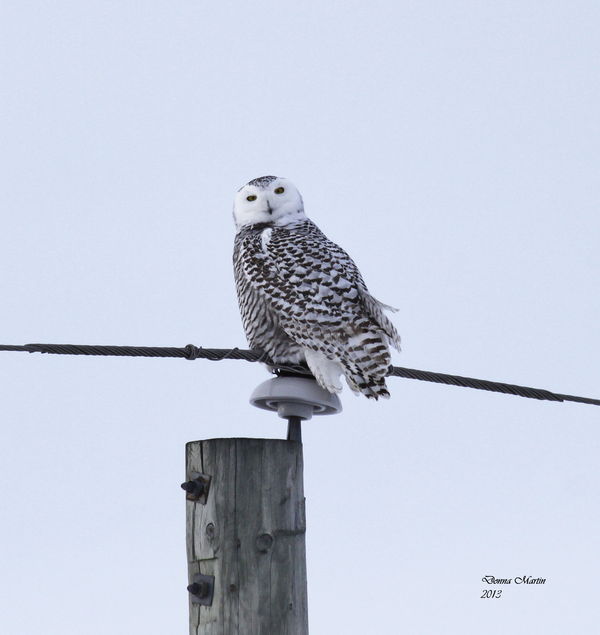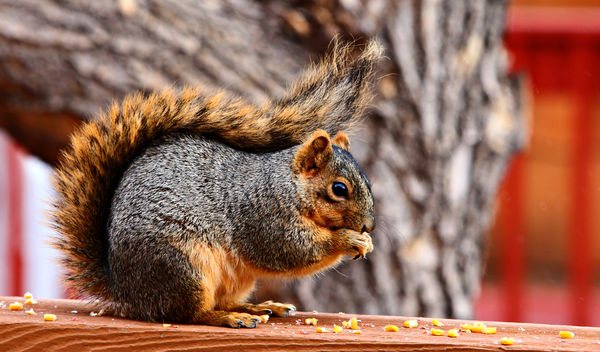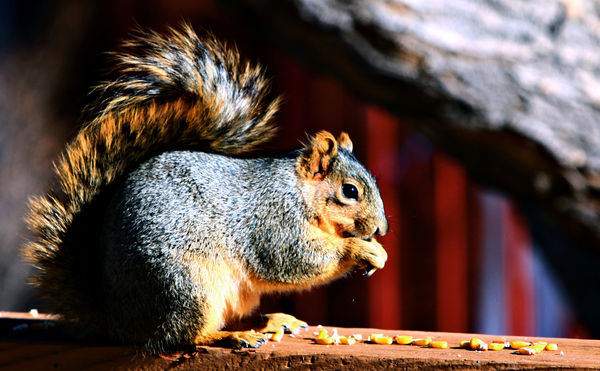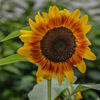Shooting white on white on overcast days
Jan 14, 2013 08:01:55 #
Fleecy45
Loc: PEI, Canada
Hi
I have a question regarding shooting on overcast days during the winter. I have recently taken pictures of snowy owls, and although the pic itself is ok the colors are like drab, grey on grey on grey with no contrast. Is there someway to boost color during these times , is there something or some settings I might be missing, I am not a professional just someone wanting to learn more and take better pictures
Thanks a bunch :)
I have a question regarding shooting on overcast days during the winter. I have recently taken pictures of snowy owls, and although the pic itself is ok the colors are like drab, grey on grey on grey with no contrast. Is there someway to boost color during these times , is there something or some settings I might be missing, I am not a professional just someone wanting to learn more and take better pictures
Thanks a bunch :)

Jan 14, 2013 08:34:17 #
Your camera WANTS to balance the shot to 18% grey. With all that white in the scene shoot at up to 2 stops over. Or shoot in RAW and you can adjust exposure in Lightroom
Jan 14, 2013 10:04:26 #
MT Shooter wrote:
Your camera WANTS to balance the shot to 18% grey. With all that white in the scene shoot at up to 2 stops over. Or shoot in RAW and you can adjust exposure in Lightroom
I am not needed to back up Mr Shooter. He is one of the most reliable here.
I would like to make a couple points, however. The obvious correction for a white background is to be unintuitive and increase exposure over the meter.
The appearance of sharpness on a gray day is a problem not always controllable. The light is so flat that you loose those tiny shadows that can tell the eye of sharpness. This is not film where one often slightly underexposes to make the colors appear more saturated.
An of course, RAW is good. But there is a better way to shoot RAW than to consider increasing exposure post capture. It is called ETTR - exposing to the right. The brightest f/stop of an image holds a full half of the image data (assuming it is not really over exposed). Therefore, there is a lot more detail in the image by shooting to the high exposure than towards the shadows.
The advantage of shooting to the right are more detail and less noise than by adjusting from dark to light. It is really a much overlooked, basic concept of DIGITAL capture and post process. It deserves a long discussion and there is much information available by doing a web search.
I would be foolish to disagree with MR Shooter. His concept of increasing exposure is proper - in camera. It gives a better exposed image, but you are hampering yourself if you do it post capture.
Thanks M T.
Jan 14, 2013 10:29:24 #
Fleecy45
Loc: PEI, Canada
Thanks for the info and I will definately try upping the f stops. I do'nt have photoshop and actually was shooting owls and tried raw for the first time and when I went to upload to computer was not be able to open the pics, so I will need a post processing software to shoot in raw. I also noticed they fill up the cards very fast, once I get a program I will try shooting in raw again,
MT Shooter wrote:
Your camera WANTS to balance the shot to 18% grey. With all that white in the scene shoot at up to 2 stops over. Or shoot in RAW and you can adjust exposure in Lightroom
Jan 15, 2013 05:51:15 #
Fleecy45 wrote:
Thanks for the info and I will definately try uppi... (show quote)
Also, buy a bigger card, as big as you can afford. You won't regret it
Jan 15, 2013 06:23:27 #
Fleecy45 wrote:
Hi
I have a question regarding shooting on overcast days during the winter. I have recently taken pictures of snowy owls, and although the pic itself is ok the colors are like drab, grey on grey on grey with no contrast. Is there someway to boost color during these times , is there something or some settings I might be missing, I am not a professional just someone wanting to learn more and take better pictures
Thanks a bunch :)
I have a question regarding shooting on overcast days during the winter. I have recently taken pictures of snowy owls, and although the pic itself is ok the colors are like drab, grey on grey on grey with no contrast. Is there someway to boost color during these times , is there something or some settings I might be missing, I am not a professional just someone wanting to learn more and take better pictures
Thanks a bunch :)
This article might help you.
http://www.dpmag.com/how-to/tip-of-the-week/how-to-shoot-on-gray-winter-days-1-14-13.html?utm_source=newslettertotw&utm_medium=email&utm_campaign=DPTOTWeNews_011413
Jan 15, 2013 07:49:16 #
Fleecy45
Loc: PEI, Canada
Thanks everyone for your help. Getting a bigger card is priority on my list!!the last time I was out shooting, filled the memory card and had to stop and take the time to erase pics, it was crazy, i was so upset at myself.
Thanks for all the tips and articles, it makes more and more sense the more I am told and the more I read
Thanks for all the tips and articles, it makes more and more sense the more I am told and the more I read
Jan 15, 2013 07:52:09 #
Fleecy45
Loc: PEI, Canada
I posted some owl pics that I have taken in the last week to 10 days in the photography section, there is no comparison on Sunny days
Jan 15, 2013 08:17:50 #
Fleecy45, keep in mind that all cameras start with raw: the raw, unedited data from the sensor. In converting from raw to jpg, the camera applies various corrections to contrast and sharpness. Therefore, raws almost always require adjusting contrast and sharpness in addition to exposure. While this might seem to be an unnecessary hassle, you will bet a better result than with jpg. Furthermore, the raw file never changes (non-destructive editing)and the final jpg, tiff, psd saves the changes.
As for this photo, cropping and increasing the contrast and sharpness should help a lot. As for exposure, use the histogram when shooting.
Hope this helps.
As for this photo, cropping and increasing the contrast and sharpness should help a lot. As for exposure, use the histogram when shooting.
Hope this helps.
Jan 15, 2013 09:31:47 #
Fleecy45 wrote:
Hi
I have a question regarding shooting on overcast days during the winter. I have recently taken pictures of snowy owls, and although the pic itself is ok the colors are like drab, grey on grey on grey with no contrast. Is there someway to boost color during these times , is there something or some settings I might be missing, I am not a professional just someone wanting to learn more and take better pictures
Thanks a bunch :)
I have a question regarding shooting on overcast days during the winter. I have recently taken pictures of snowy owls, and although the pic itself is ok the colors are like drab, grey on grey on grey with no contrast. Is there someway to boost color during these times , is there something or some settings I might be missing, I am not a professional just someone wanting to learn more and take better pictures
Thanks a bunch :)
Make sure your white balance is set to cloudy or shade.
If you have a Nikon you can adjust the Picture Controls to make the images more vivid. One of the choices is "Vivid" and you can adjust it to make it more Vivid by increasing saturation and trying some other things.
If non Nikon you probably have the same capability by a different name.
Another option is to shoot in RAW and work on it in post processing with something like Photoshop Elements.
Jan 15, 2013 09:42:15 #
Fleecy45 wrote:
Thanks for the info and I will definately try uppi... (show quote)
MT Shooter was suggesting upping the Exposure. That means reducing the f-stop. As noted it isn't intuitive.
Although I understand and agree with the general advice I don't think it would have worked on this shot. Although the thumbnail image may be decieving the right side of the birds face appears blown out already. If you up the exposure you'd blow out even more of the image.
Shooting in RAW and spot metering on the bird might be your best options here.
Jan 15, 2013 13:49:29 #
Fleecy45 wrote:
Hi
I have a question regarding shooting on overcast days during the winter. I have recently taken pictures of snowy owls, and although the pic itself is ok the colors are like drab, grey on grey on grey with no contrast. Is there someway to boost color during these times , is there something or some settings I might be missing, I am not a professional just someone wanting to learn more and take better pictures
Thanks a bunch :)
I have a question regarding shooting on overcast days during the winter. I have recently taken pictures of snowy owls, and although the pic itself is ok the colors are like drab, grey on grey on grey with no contrast. Is there someway to boost color during these times , is there something or some settings I might be missing, I am not a professional just someone wanting to learn more and take better pictures
Thanks a bunch :)
In addition to what else has been posted here, another possible long term solution might to be to have an external handheld light meter and take an incidence light reading of the light falling on the owl, time permitting, and whether or not the sun is shining through the cloudiness and if so, at what angle. On a day like that you should be able to get a good reading to use in setting your camera in manual mode from where you're standing fairly effectively. Look at the first url below and if you are intrigued, you can look further into other benefits of an external meter in the headings above, including some tutorial videos. There was a thread yesterday here on uhh about external meters and if you're interested in that discussion, reference the second url below:
http://www.sekonic.com/Classroom/MeteringTechniques/IncidentvsReflected.aspx
http://www.uglyhedgehog.com/t-89354-1.html
Jan 15, 2013 13:54:28 #
Bad light is bad light and there isn't much you can do about it. Yes, there are a few things as mentioned above that you can try, but short of Photoshoping the crap out of your image there isn't much you can do. I still shoot on overcast days, but I don't expect to keep much. Once in a while I may see something rare (for my area) that I would like to have in good or bad light. I usually keep em until I get a shot in better light. Keep shooting and try to capture that beautiful owl in better light and in a more natural setting instead of on wires. I have many images like this that I captured when I was new to photography but now I'm always trying to get a better image in a natural setting, in good light, with a good BG (back ground), that is perfectly exposed and tack sharp. These shots are hard to come by so keep trying.
Jan 15, 2013 14:04:20 #
jeep_daddy wrote:
Bad light is bad light and there isn't much you ca... (show quote)
Let's not give overcast days a bad name. For many photos the soft light provided by overcast days is perfect. For example outdoor people pics.
I prefer overcast days for colorful rock formations. The colors are much more saturated.
Jan 15, 2013 14:23:42 #
MtnMan wrote:
quote=jeep_daddy Bad light is bad light and there... (show quote)
Oh yow, I love a good overcast day but not when my subject is sitting front of the sky. When you're out, randomly shooting various subject matter in any direction regardless of where your light is coming from is not an easy feat and challenges everything you, as a serious hobbyist photographer, are going to learn in the next twenty years if you always succeed. If you're a pro, you've got another set of problems. Realizing in advance what will and won't make a good image is a major part of the learning process with this stuff. Collecting a bunch of bad shots of astoundingly good subject matter is a major part of it. It can be very disappointing to encounter what may very well turn out to be a once in your lifetime event and you "muff" it but that's part of it, dang-it. Here's two shots made with no special metering attempt, the basic difference of which is the light hitting the subject:


If you want to reply, then register here. Registration is free and your account is created instantly, so you can post right away.






